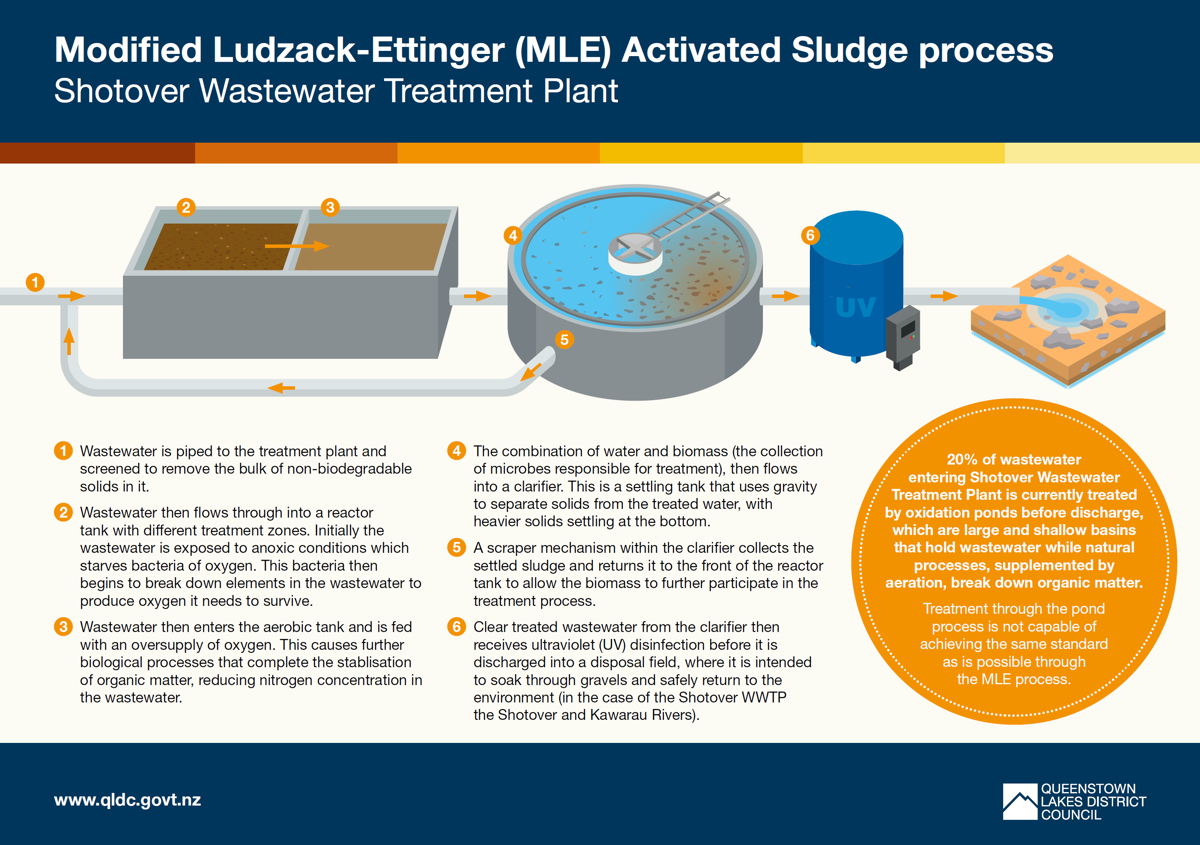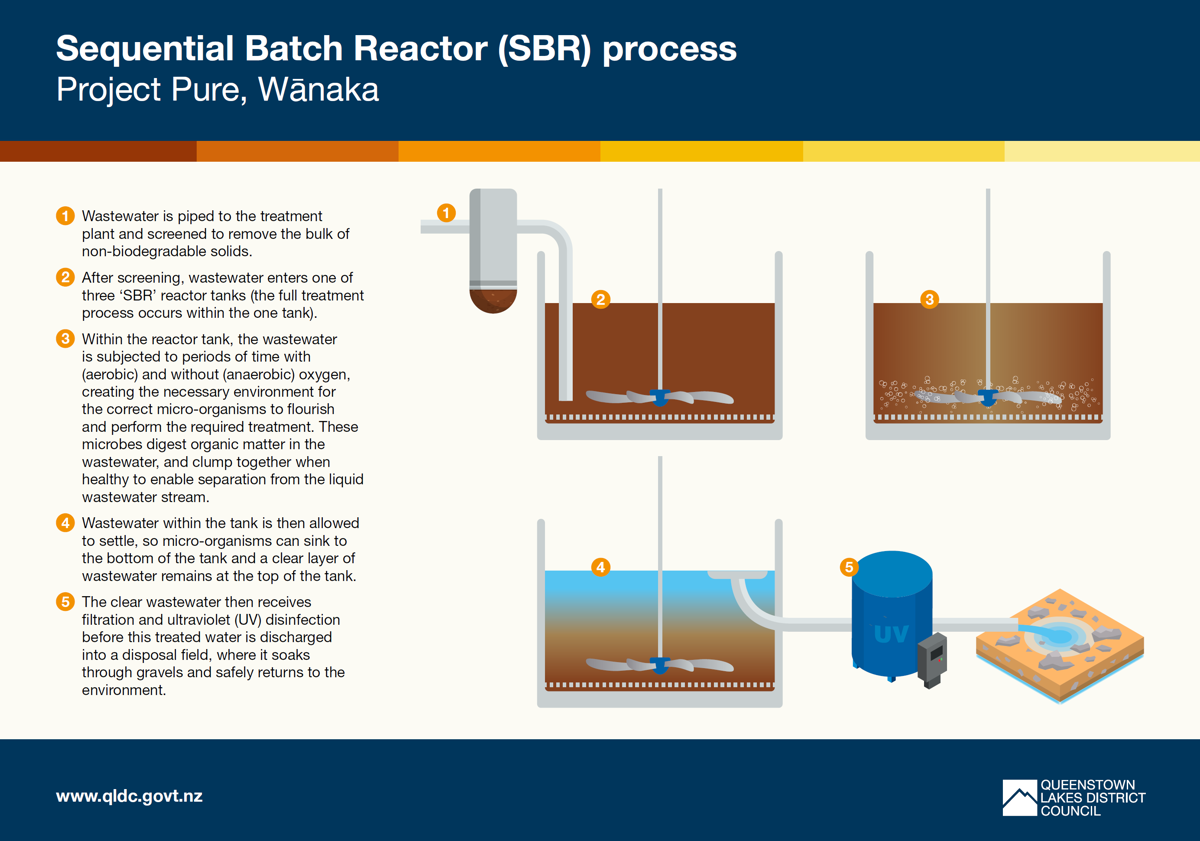- Services
- Rates & Property
- Rubbish & Recycling
- Building Services
- Resource Consents
- Environmental Health
- Transport and Parking
- Alcohol Licensing
- Animal Control
- Airports
- Environment and Sustainability
- Water Services
- Cemeteries
- Services A - Z
- Summer Services
- CCTV - Public Use
- Permits
Wastewater
Wai para
Wastewater is the name for everything that gets flushed down the toilet or washed down your kitchen/bathroom sink, shower or laundry.
Quick links
About our wastewater network
One of the most important services we provide is the reticulation and treatment of wastewater on behalf of residents and ratepayers, before safely returning the treated water to the environment.
Currently, we service the wastewater needs of over 21,000 residential properties in the Queenstown Lakes District, and more than 2,900 non-residential properties, resulting in an average of 14,521m3 of wastewater produced each day.
This wastewater is then managed by a network made up of 551km of pipes, 65 pump stations, and four treatment plants throughout the district (located in Queenstown/Frankton, Wānaka, Hāwea, and Cardrona).
How we treat wastewater
We use a range of different methods across the district to treat the wastewater we produce. As an example Project Shotover uses a Modified Ludzack-Ettinger (MLE) Activated Sludge process to treat wastewater before returning it to the environment.

Enlarge the treatment process image above.
-
Wastewater is piped to the treatment plant and screened to remove the bulk of non-biodegradable solids in it.
-
Wastewater then flows through into a reactor tank with different treatment zones. Initially the wastewater is exposed to anoxic conditions which starves bacteria of oxygen. This bacteria then begins to break down elements in the wastewater to produce oxygen it needs to survive.
-
Wastewater then enters the aerobic tank and is fed with an oversupply of oxygen. This causes further biological processes that complete the stabilisation of organic matter, reducing nitrogen concentration in the wastewater.
-
The combination of water and biomass (the collection of microbes responsible for treatment), then flows into a clarifier. This is a settling tank that uses gravity to separate solids from the treated water, with heavier solids settling at the bottom.
-
A scraper mechanism within the clarifier collects the settled sludge and returns it to the front of the reactor tank to allow the biomass to further participate in the treatment process.
-
Clear treated wastewater from the clarifier then receives ultraviolet (UV) disinfection before it is discharged into a disposal field, where it is intended to soak through gravels and safely return to the environment (in the case of the Shotover WWTP the Shotover and Kawarau Rivers.
Please note: 20% of wastewater entering Shotover Wastewater Treatment Plant is currently treated by oxidation ponds before discharge, which are large and shallow basins that hold wastewater while natural processes, supplemented by aeration, break down organic matter. Treatment through the pond process is not capable of achieving the same standard as is possible through the MLE process.
Project Pure in Wānaka uses a Sequential Batch Reactor (SBR) process to treat wastewater before returning it to the environment.

Enlarge the treatment process image above.
-
Wastewater is piped to the treatment plant and screened to remove the bulk of non-biodegradable solids.
-
After screening, wastewater enters one of three ‘SBR’ reactor tanks (the full treatment process occurs within the one tank)
-
Within the reactor tank, the wastewater is subjected to periods of time with (aerobic) and without (anaerobic) oxygen, creating the necessary environment for the correct micro-organisms to flourish and perform the required treatment. These microbes digest organic matter in the wastewater, and clump together when healthy to enable separation from the liquid wastewater stream.
-
Wastewater within the tank is then allowed to settle, so micro-organisms can sink to the bottom of the tank and a clear layer of wastewater remains at the top of the tank.
-
The clear wastewater then receives filtration and ultraviolet (UV) disinfection before this treated water is discharged into a disposal field, where it soaks through gravels and safely returns to the environment.
How we monitor wastewater quality and compliance
At the point of discharge from a facility like Shotover Wastewater Treatment Plant, treated wastewater is regularly tested to ensure it complies with consent limits set by Otago Regional Council. Typically these parameters include Biochemical Oxygen Demand (BOD), Total Nitrogen (TN), Ammoniacal Nitrogen, Total Suspended Solids (TSS) and E.coli.
Our operation teams undertake regular monitoring through onsite instrumentation, and regular analysis undertaken at on-site labs and through independent lab testing.
Shotover WWTP Monitoring Dashboard
Our new dashboard below presents the latest samples taken from Shotover Wastewater Treatment Plant and several monitoring sites throughout Shotover and Kawarau River, making it easier to track treatment performance and discharge results.
How to use the new dashboard
Filter by category
The dashboard has two categories - 'Plant Discharge' and 'River Monitoring'.
Plant Discharge shows sampling results for discharge from the WWTP and at the end of the drainage channel before discharge enters Shotover River
River Monitoring shows sampling results for several locations throughout Shotover River and Kawarau River.
Parameters
The dashboard has several parameters that can be selected to view different types of data, including E.coli, Total Nitrogen, and more. Each selected paramater includes a description explaining what it is, why it is tested for, and guidelines for rivers.
Locations
The different sampling sites can be filtered by location, which can be used to view a specific site or multiple within the one graph of data being presented below.
Graph
The dashboard's graph presents information for the parameter and locations selected, all the way back until April 2025 and since the short-term discharge into Shotover River began.
Mouse over different testing dates to see specific results.
Map
Click on the map and drag to move around the area and see where different monitoring sites are.
Please note: We recommend using the full screen toggle at the bottom of the dashboard to make it easier to navigate.
Dashboard commentary
-
Sampling results show final discharge from Shotover WWTP exceeded QLDC’s consent conditions on 6 August, following a short disruption to the treatment plant’s control system.
Close -
Shotover WWTP is currently transitioning upgrades, which in combination with
Close
colder weather is resulting in some performance variability, as evident through
the elevated result from 24 July. The team on site is working to ensure treatment
performance is optimised throughout this period. Sampling results from 31 July
show a return to normal discharge quality. -
Slightly elevated results were returned from the 12 June sample taken at RS16,
Close
but treated effluent coming from the plant had a reading of 10 CFU/100mL at the time. It is likely that rainfall contributed to the elevated E. coli result returned from the RS10 sample taken on 26 June.
Historical river monitoring data
Measures and why they're tested for
-
This is a measure of how much oxygen is needed to break down any organic material in wastewater, and is important for determining how effective wastewater treatment processes are.
High levels of cBOD5 can limit the oxygen available in a waterbody. Low oxygen levels can harm aquatic life.
Close -
TSS are particles floating in the water, and are an important, visible indicator of water quality.
Suspended solids can absorb light. Reduced light can increase water temperature and decrease oxygen levels, negatively impacting aquatic life.
Close -
Nitrogen and phosphorus help plants grow. But if levels of these nutrients in water are too high, they can increase plant and/or algae growth, over time reducing water clarity and oxygen levels.
This lack of oxygen can reduce the numbers of aquatic animals (e.g., shellfish and other invertebrates, as well as fish).
Nitrogen and phosphorous can be measured in different ways, so testing intentionally includes ‘total nitrogen’ and ‘total phosphorus’ to ensure all forms of nitrogen or phosphorous present in treated wastewater are measured.
Close -
Ammonia can reduce oxygen levels in water, resulting in reduced biodiversity and declining fish populations.
Close -
Enterococci is bacteria that occur naturally in the intestines of humans and animals. It’s a useful indicator of faecal contamination in salt water.
Close -
E. coli is a type of bacteria commonly found in the intestines of warm-blooded animals, including people.
They’re a useful indicator of whether bacteria, viruses, or protozoa (single-celled parasites, like cryptosporidium and giardia) that can make people sick are present in soil and freshwater.
Close
Investment
We’ve invested heavily in wastewater management over the last decade, with the district’s major facilities moving towards modern treatment processes capable of producing high-quality treated water.
-
Some significant wastewater projects in the district either underway or starting soon include:A third stage of upgrades underway at Project Shotover to introduce a second Modified Ludzack-Ettinger (MLE) reactor at the facility, which will mean the oxidation pond system (currently used as part of the treatment process for 20% of wastewater flows into the facility) can be decommissioned. More information on these upgrades can be found here.
-
Upgrades to the Upper Clutha’s wastewater network starting soon, which will futureproof Hāwea’s wastewater needs, and increase the capacity and resilience of the wider Wānaka and Albert Town network. Click here for more information.
An additional $77M is allocated in the 2024-34 Long Term Plan for a new disposal solution at Project Shotover, and an additional $80.1M for further improvements to the Upper Clutha network.





